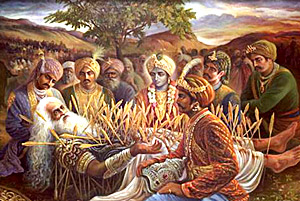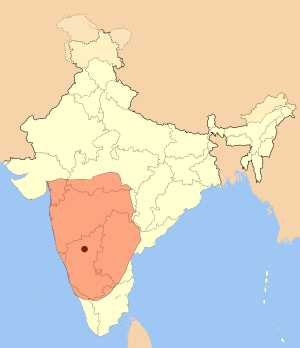
Harappa Environment
During this period, the climate of the region was moist with humid land; dense forests grew where animals like tiger, elephants and rhinoceros roamed. The forests provided timber for brick kilns, which supplied bricks to the cities.
Date of Harappan Culture
This civilization belonged to the Chalcolithic period. In this age, a new metal called bronze by mixing tin and copper came to be produced. It was harder and better suited to meet the needs of the people. The better tools led to intensive cultivation. Iron was not known to the Indus Valley people. According to Sir John Marshall, the Hindus Valley Civilization may be dated between 3250 B.C. arid 2750 B.C.
Extent
The Harappan culture spread to Sindh, Gujarat. Undivided Punjab (including Harayana), Jammu, Western parts of Uttar Pradesh and Northern parts of Rajasthan (Kalibangan). The remains found in these places are similar to those found in Harappa and Mohenjo-daro.
Contacts with other civilizations in Harappa
The indus Valley people had overseas trade contacts with Sumeria, Babylonia and Egypt, Thus India ranks with the ancient Western cultures of Burner, Akkad, Babylon, Egypt and Assyria.
Planned Cities in Harappa
Mohenjo and Harappa were the planned cities. They were the two biggest cities, 600 km apart. They had similar planning, layout and technique in construction. They were probably the twin capitals. Mohenjo-daro, means ‘the mound of the dead’.
The city of Mohenjo-dato could be divided into three parts-the Citadel, the lower town arid the small huts on the outer limits of the city.
The Citadel in Harappa
It was the raised part of the city. It has often been described as a fort or administrative block. People might have lived here. The ruling classes included priests and wealthy merchants. The citadel had massive walls. Those walls provided protection against the floods of the Indus river. The citadel consisted of important buildings like the Granary and the Assembly or Town Halls, We also come across the Great Bath here.
The Great Bath
it was situated in the citadel, it measures 1.88 meters X 7.01 meters and is 2.43 meters deep. It had two flights or steps on oTher side, It was made of burnt bricks and mortar, it was provided with two openings one at the top (to let in water) and the other a the bottom (used as an outlet), The idea was to clean the Bath periodically. 1”here were small rooms around tile Bath. They were probably used as dress changing rooms. One of the rooms contained a big well.
The Granary in harappa
In Mohenjo-daro the arqost building is the Granary. It s 45,71 meters long and 15.23 meters wide. In Harappa there were 6 granaries. To the sooth of the granaries, there were circular brick platforms. They were meant for threshing grain.
Town Hall in Harappa
The Town Hall is an imposing structure with 69 meters long arid 23.4 meters wide. The thickness of the walls varied from 1.2 to 1.5 meters. lt might have been used as an administrative block, an assembly hall, a prayer hall, or as a hall for cultural shows.
Lower Town in Harappa
Below the citadel laid a lower town. It was inhabited by petty merchants and craftsmen. This town was divided into rectangular blocks by wide roads. The roads run from north to south and east to west. These roads cut each other at right angles. Here, the remains of brick houses can be seen. The drainage system is praiseworthy. Provision was made for street lighting.
Harappan Houses
The houses were one or two storey high. All the houses were made of baked bricks of uniform size. Every house had two or more rooms, a bath-room, a kitchen and a courtyard. The houses were also provided with doors and small windows The grinding stones were found close to the hearth
Drainage System in Harappa
The kitchen and the bathroom had drains leading out. The main drain was running alongside the main roads. The drains were lined with bricks. Most of them were covered. There were flights of steps leading to drains. The drains were cleaned periodically.
Occupations of the people in Harappa
The Indus people were farmers, weavers, potters, metal workers, toy makers, jewelers, stone cutters and traders Agriculture was the most important occupation In the fertile soils, farmers cultivated two crops a year They were the first who had grown paddy They knew different methods of irrigation. They used ploughs and sickles Pottery was a popular industry. They were skilled in the use of potter’s wheel.
Animal Husbandry in Harappa
The Indus people had domesticated a number of animals such as oxen, buffaloes, goats, sheep, pigs, asses and camels.
Spinning and Weaving in Harappa
The Indus people were skilled in the art of spinning and weaving. They manufactured woollen cloth from sheep and goats’ hair.
Toy-making and sculptures in Harappa
Manufacture of terracotta (burnt clay) was a major industry of the people. The figures of toys, animals and figurines were manufactured. A miniature toy-cart with a driver pulled by oxen is praiseworthy. Figures of animals such as sacred bull and dove were discovered. The figures of Mother Goddesses were used for religious purposes
Seal-making in Harappa
A large number of seals numbering more than 2000 have been discovered. They carry short inscriptions with carved pictures of animals. The seals were made of terracotta or satellite. They were used for trade. They have provided lot of information about the daily life of the people, their religion, occupations, customs and trade.
Building Industry in Harappa
In building industry, large number of people were employed Manufacture of bricks was an important industry. The bricks were more or less of an uniform size.
Trade in Harappa
The lndus people had engaged themselves in internal and foreign trade The Mesopotamian seals were found in Indus cities and the Indus seals were found in Mesopotamia. Remains of dockyard have been discovered at Lethal in Gujarat. In this dockyard, the ships might have been loaded and unloaded. Thus, the Hindus people were familiar with ships. The merchants were prosperous and lived lavishly. They used sticks with marks to measure articles. They also used various kinds of weights and measures.
Political Organization in Harappa
The city was well administered by a class of wealthy merchants and priests. There was some kind of municipal organization It took care of sanitation and regulated trade. It collected taxes in the form of grains and also maintained law and order in the city
Social Life in Harappa
There were three social groups. The first group or the ruling class lived in the citadel It comprised of wealthy merchants and the high priests. They second group consisted of petty merchants, artisans arid craftsmen. The laborers belonged to the third group and lived in small huts. Generally speaking, the social organization was more definite
Life of the People in Harappa
The Indus people led prosperous life. They had more time for leisure. There was a very big improvement in their food habits, dress and amusements.
Food in Harappa
Wheat and barley were the staple food of the people. Besides these, they consumed milk, meat, fish, fruits and dates.
Dress and Ornaments in Harappa
The women wore a short skirt. It. was held at the waist with a girdle. The men wore a long, loose unstitched garment Women wore necklaces bangles, bracelets, earrings and waist bands. These were made of gold and silver, bone, stone, ivory and she! Men had also adorned themselves with ornaments like armlets. The rich wore gold and silver jewelry. The poor used shell, copper and silver ornaments. The women combed their hair.
Indus Script in Harappa
Indus Script Most of the inscriptions were engraved on seals They contain only a few words They developed picture writing (Pictographs,,). Altogether about 250 to 400 pictographs were discovered. It is interesting to note that the Indus script has not yet been deciphered.
Religious Life in Harappa
The Papal tree was used as a religious symbol. They worshipped Pasupathi (Siva) and Mother Goddess Mother Goddess represented fertility. There are no temple structures among the remains. The Indus people believed in life after death. They buried their dead in huge earthen pots along with food and ornaments. The articles used by them in then’ daily life were also kept in those pots.
Decline of the Indus Civilization
The Indus Civilization was at its peak for about 500 years They lived in the same kind of houses, used the same tools and ate the same food. The city (Mohenjo-daro) was destroyed for a number of times and it was built again and again. The exact causes for the destruction of this great civilization are not known. The cities might have been destroyed by natural disasters like earthquakes, floods or a change in the course of the Indus. The cities declined owing to Aryan invasions also. Deforestation was another cause for the destruction of this civilization
The Harappan did not know the use of iron.
Courtesy--http://www.indiaandindians.com/india_history/harappan_civilization.php




 Reblog this post [with
Reblog this post [with 
















